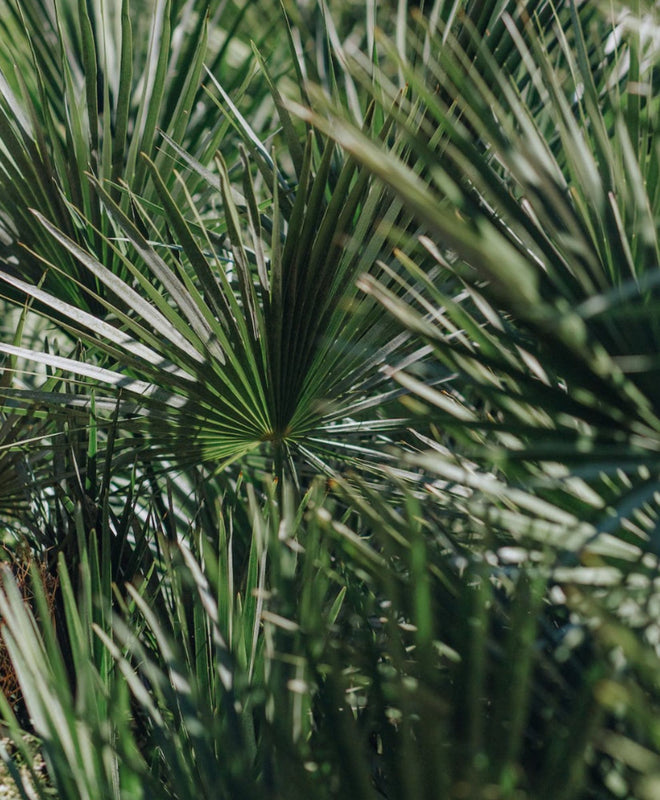
Care sheet: Saw Palmetto
Pas le temps de tout lire ? 👇Cliquez ici pour un résumé👇
Sommaire

The dwarf shrubby palm is of the genus Chamaerops, it is the only species that remains small and never exceeds 3 meters. Originally from the eastern Mediterranean basin, it grew up in rocky or sandy areas.
At Paris Pousse Marcel the accomplished is available alone or in one of the three elegant jars available.

It is a plant that adapts best, and one of the most favorable to growing indoors , on a terrace or balcony . Its fruits are not to be eaten, despite their attractive red-brown appearance.
--------------------------------------------
MAINTENANCE SHEET
☀️ Exposure: The sun is beneficial to it and will be especially appreciated in winter.
💧 Watering: Even if it is resistant to drought, daily watering with rainwater is recommended during hot weather. Wait until the soil is completely dry on the surface before repeating the operation. Pot culture requires, to avoid nutritional deficiencies, a supply of fertilizer once or twice a year, especially in spring.
❌ Cultivation errors: This hardy palm resists temperatures of -15°C, provided it is planted in well-drained soil. However, drafts are to be avoided, just as it is better to avoid soils that are too humid and therefore heavy. If it supports spray as much as drought, be sure to protect it, even for a pot culture.
--------------------------------------------
🤢 DISEASES AND PESTS
Above all, the presence of palm pest moths, thrips and leaf spot disease are to be feared.
The treatment of the small black pycnidia which cover the palms induces the destruction of those which are covered with brown or gray spots and turn yellow. As for pests, to detect and eliminate such insects follow these simple tips:
Consequences: The thrips discolor the young leaves, which turn silver when they are rife. The destructive butterfly, for its part, devours the heart of the palm tree and causes the first palms to wither.
Solution: Spraying 2 or 3 times a special mite insecticide to treat the foliage, every two weeks is enough. Since the scourge of the palm tree is the caterpillar of the devastating butterfly, a solution that respects biodiversity exists at Biotop.
Beware of the red weevil outdoors which, like scale insects which can affect the palm tree, should be treated as we have just indicated. Do not forget to insist on the back of the fins where they like to stay.
--------------------------------------------
🌱 HOW TO REPOT A DWARF PALM TREE?
Planting in a pot: Whether you choose to place it outdoors or in your home, the palm tree is equally suited to pots and containers. This is an advantage because, if you have to put it under shelter in winter, moving it is easier.
1- A large container is not necessary, choose a pot larger than the root ball of the palm tree is sufficient at first.
Pruning is useless, remove dried leaves and dead branches piecemeal.
2- Excess water is difficult for palm trees to tolerate, so it is imperative to ensure good drainage. A thick layer of clay balls at the bottom of the pot, or even gravel, will be enough to prevent it from rotting.
3- In order to be able to regulate the humidity of the substrate, it must consist of quality soil, not sandy or clayey. Prefer autumn to promote recovery, because this is the time when rooting is best.
Good to know: Saw palmetto extracts have therapeutic properties! Combined with nettle root, they can relieve benign prostatic hyperplasia, as well as the unpleasant urinary symptoms that come with it. Avoid any self-medication before consulting a doctor, even if clinical trials have proven the validity of the treatment.
Note: As for the Seminoles, they were already using this medication for prostate disorders. It is also as food that they
once used the berries of the dwarf palm, a complement to which our European palates have never been able to adapt.
Written by Sarah Delaval